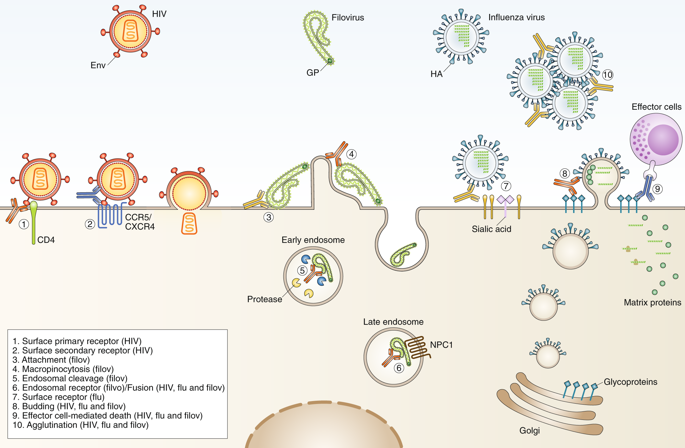当前位置:
X-MOL 学术
›
Nat. Microbiol.
›
论文详情
Our official English website, www.x-mol.net, welcomes your
feedback! (Note: you will need to create a separate account there.)
Antibody responses to viral infections: a structural perspective across three different enveloped viruses.
Nature Microbiology ( IF 20.5 ) Pub Date : 2019-03-18 , DOI: 10.1038/s41564-019-0392-y Charles D Murin 1 , Ian A Wilson 1, 2, 3 , Andrew B Ward 1, 2
Nature Microbiology ( IF 20.5 ) Pub Date : 2019-03-18 , DOI: 10.1038/s41564-019-0392-y Charles D Murin 1 , Ian A Wilson 1, 2, 3 , Andrew B Ward 1, 2
Affiliation

|
Antibodies serve as critical barriers to viral infection. Humoral immunity to a virus is achieved through the dual role of antibodies in communicating the presence of invading pathogens in infected cells to effector cells, and in interfering with processes essential to the viral life cycle (chiefly entry into the host cell). For individuals that successfully control infection, virus-elicited antibodies can provide lifelong surveillance and protection from future insults. One approach to understand the nature of a successful immune response has been to utilize structural biology to uncover the molecular details of antibodies derived from vaccines or natural infection and how they interact with their cognate microbial antigens. The ability to isolate antigen-specific B-cells and rapidly solve structures of functional, monoclonal antibodies in complex with viral glycoprotein surface antigens has greatly expanded our knowledge of the sites of vulnerability on viruses. In this Review, we compare the adaptive humoral immune responses to human immunodeficiency virus (HIV), influenza and filoviruses, with a particular focus on neutralizing antibodies. The pathogenesis of each of these viruses is quite different, providing an opportunity for comparison of immune responses: HIV causes a persistent, chronic infection; influenza, an acute infection with multiple exposures during a lifetime and annual vaccination; filoviruses, a virulent, acute infection. Neutralizing antibodies that develop under these different constraints are therefore sentinels that can provide insight into the underlying humoral immune responses, as well as important lessons to guide future development of vaccines and immunotherapeutics.
中文翻译:

抗体对病毒感染的反应:三种不同包膜病毒的结构视角。
抗体是病毒感染的关键屏障。对病毒的体液免疫是通过抗体在将感染细胞中入侵病原体的存在传达给效应细胞和干扰病毒生命周期所必需的过程(主要是进入宿主细胞)中的双重作用来实现的。对于成功控制感染的个体,病毒引发的抗体可以提供终身监测和保护免受未来侵害。了解成功免疫反应性质的一种方法是利用结构生物学来揭示源自疫苗或自然感染的抗体的分子细节,以及它们如何与其同源微生物抗原相互作用。分离抗原特异性 B 细胞和快速解析功能结构的能力,与病毒糖蛋白表面抗原复合的单克隆抗体极大地扩展了我们对病毒易受攻击部位的了解。在这篇综述中,我们比较了对人类免疫缺陷病毒 (HIV)、流感和丝状病毒的适应性体液免疫反应,特别关注中和抗体。每种病毒的发病机制都大不相同,这为比较免疫反应提供了机会: HIV 会导致持续的慢性感染;流感,一生中多次接触的急性感染,每年接种疫苗;丝状病毒,一种剧毒的急性感染。因此,在这些不同限制条件下产生的中和抗体是可以深入了解潜在体液免疫反应的哨兵,
更新日期:2019-05-16
中文翻译:

抗体对病毒感染的反应:三种不同包膜病毒的结构视角。
抗体是病毒感染的关键屏障。对病毒的体液免疫是通过抗体在将感染细胞中入侵病原体的存在传达给效应细胞和干扰病毒生命周期所必需的过程(主要是进入宿主细胞)中的双重作用来实现的。对于成功控制感染的个体,病毒引发的抗体可以提供终身监测和保护免受未来侵害。了解成功免疫反应性质的一种方法是利用结构生物学来揭示源自疫苗或自然感染的抗体的分子细节,以及它们如何与其同源微生物抗原相互作用。分离抗原特异性 B 细胞和快速解析功能结构的能力,与病毒糖蛋白表面抗原复合的单克隆抗体极大地扩展了我们对病毒易受攻击部位的了解。在这篇综述中,我们比较了对人类免疫缺陷病毒 (HIV)、流感和丝状病毒的适应性体液免疫反应,特别关注中和抗体。每种病毒的发病机制都大不相同,这为比较免疫反应提供了机会: HIV 会导致持续的慢性感染;流感,一生中多次接触的急性感染,每年接种疫苗;丝状病毒,一种剧毒的急性感染。因此,在这些不同限制条件下产生的中和抗体是可以深入了解潜在体液免疫反应的哨兵,


















































 京公网安备 11010802027423号
京公网安备 11010802027423号